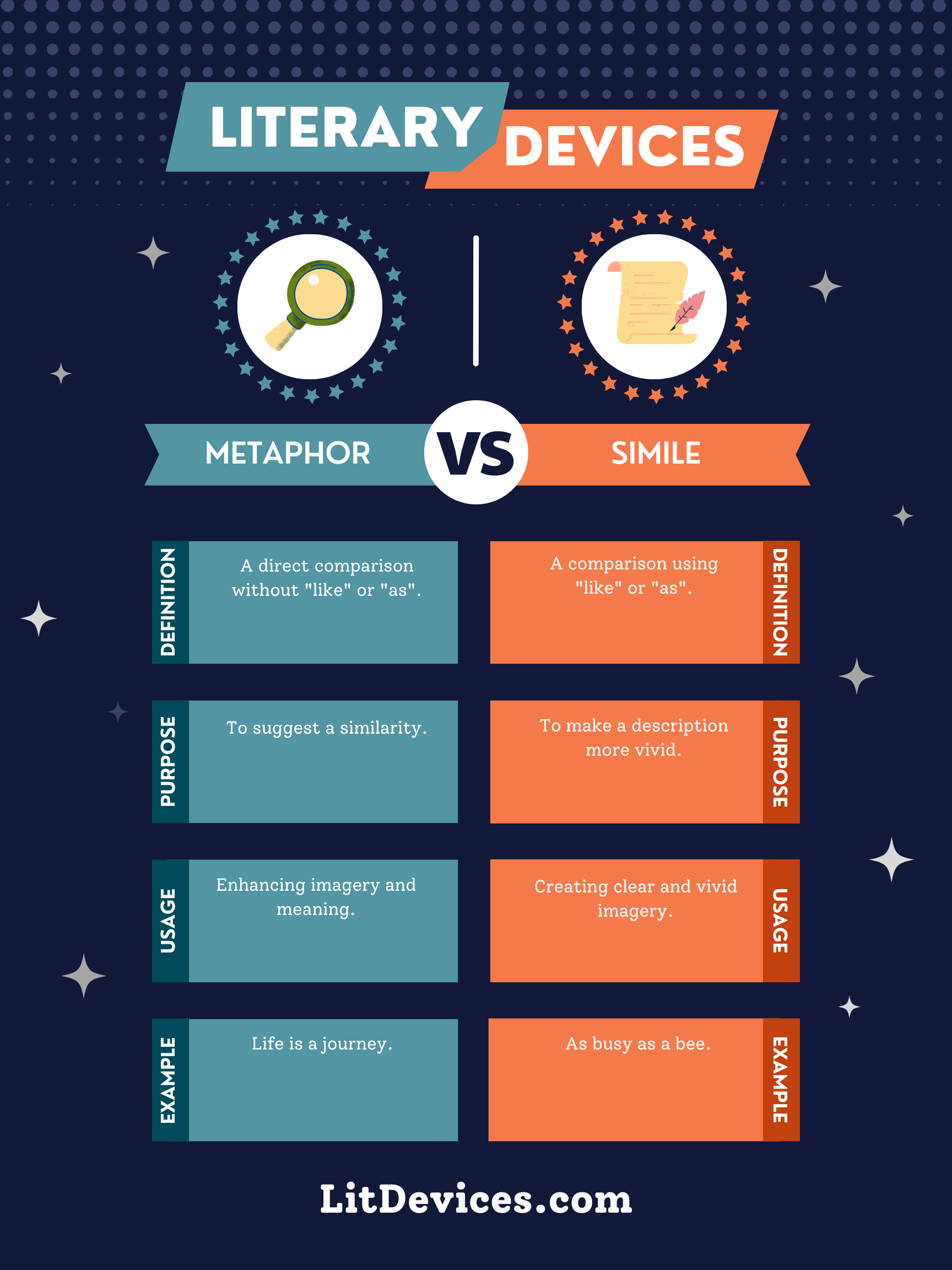Metaphor directly compares two things without “like” or “as”; Simile uses “like” or “as” for comparison.
Metaphor
A metaphor is a figure of speech that describes an object or action in a way that isn’t literally true, but helps explain an idea or make a comparison. It states that one thing is another thing, directly equating two things for a powerful effect.
🌟 Example: “Time is a thief.” Here, time is not literally stealing anything, but this metaphor suggests that time can take away our moments without any warning, just like a thief.
Simile
A simile, on the other hand, compares two different things to illustrate a common quality between them, explicitly using the words “like” or “as.”
🌈 Example: “Her smile is like sunshine.” This simile conveys that her smile is bright, warm, and makes you feel good, similar to sunshine.
Summary
| Literary Device | Definition | Purpose | Usage | Relevant Examples |
|---|---|---|---|---|
| Metaphor | A direct comparison between two unrelated things, stating one is the other. | To create a vivid image or make an abstract concept more relatable. | Often used for deeper, more complex comparisons. | “The world’s a stage.” |
| Simile | A comparison between two unlike things using “like” or “as.” | To make descriptions more expressive and easier to visualize. | Typically used for simpler, more direct comparisons. | “Busy as a bee.” |
Writing Tips
When it comes to utilizing metaphors and similes in your writing:
- Be creative but clear. While metaphors allow for more abstract comparisons, ensure your reader can follow the connection. For similes, clarity comes with the direct comparison, but don’t let it be dull.
- Use sparingly for impact. Too many metaphors or similes can overwhelm your reader and dilute the power of your prose.
- Practice with purpose. Experiment with both devices in your writing to see how they can best serve your narrative or message.
🖋 Example for Metaphor: Instead of saying “Life is unpredictable,” try “Life is a rollercoaster.” It conveys the ups and downs and the unpredictability of life in a more vivid manner.
🖋 Example for Simile: To describe someone’s speed, instead of simply saying “He runs fast,” you might say “He runs like the wind,” which gives a clearer image of his speed.
FAQs
What is the main difference between a metaphor and a simile?
A metaphor makes a direct comparison by stating something is something else, while a simile uses “like” or “as” to make a comparison.
Can metaphors and similes be used interchangeably?
While they both compare, the impact and usage context can differ, making them not always interchangeable. Metaphors are for more intense, immersive imagery, whereas similes are more straightforward and easy to understand.
How do metaphors and similes improve writing?
They add depth and creativity to writing, making descriptions more vivid and engaging for the reader.
Exercise
Read the following sentences and identify whether each is a metaphor or a simile:
- The fog was a cotton blanket over the city.
- She danced like a leaf in the wind.
- His heart is a cold iron.
- Life is as fleeting as a shooting star.
Answers:
- Metaphor
- Simile
- Metaphor
- Simile
Interesting Literary Device Comparisons
- Personification vs. Metaphor: Personification gives human characteristics to inanimate objects or abstract ideas, while metaphors directly compare two things.
- Hyperbole vs. Simile: Hyperboles are exaggerated statements not meant to be taken literally, whereas similes are comparisons using “like” or “as.”
- Alliteration vs. Assonance: Both are stylistic devices that use sound to enhance the reading experience, but alliteration repeats consonant sounds at the beginnings of words, while assonance repeats vowel sounds within words.
Exploring these and other literary devices can further enrich your writing toolkit!

